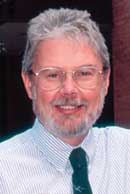From the Director
by Lee Allison,
Director and State Geologist

The future of the Ogallala aquifer involves
more than Kansas alone
The
Ogallala aquifer is crucial to the future of Kansas. Yet the future of
the Ogallala aquifer involves more than Kansas alone. The Ogallala lies
beneath parts of eight states. It is a complex package of different types
of sediments with physical properties such as thickness, porosity, and
permeability that vary vertically and from place to place. As a result,
the storage capacity and productivity of the aquifer vary dramatically.
Understanding of the Ogallala aquifer is also uneven across the eight-state region. Out of hundreds of thousands of wells in the aquifer, only about 9,500 are measured annually to determine changes in the water table. Kansas water databases are far more extensive than those in other states, giving Kansans a fuller and more detailed understanding of the aquifer. However, our knowledge is still inadequate to answer many of the questions about appropriate management of this dwindling resource.
The eight state geological surveys and the U.S. Geological Survey have formed the High Plains Aquifer Coalition with the objective of improving the geological characterization and understanding of the High Plains aquifer, of which the Ogallala is the largest component. The Coalition is currently compiling data and reports from each state, information that will be used to develop a plan of scientific study for the High Plains aquifer.
Concurrent with the formation of the Coalition, legislation was introduced in Congress to authorize funding for geologic mapping and modeling of the aquifer as part of a broader agriculture initiative in the House, and as a stand-alone bill in the Senate. Co-sponsorship of the bills is bipartisan and multi-state, but given the importance of the aquifer to so many communities, these bills are being intensely scrutinized. The legislation authorizing geologic study can be enacted independently of the agriculture bill. Its passage will help unravel the mysteries of the Ogallala and lead to better understanding of this important, widespread resource.
![]()
Online February 10, 2003
Comments to: lbrosius@kgs.ku.edu
Kansas Geological Survey
URL:http://www.kgs.ku.edu/Publications/GeoRecord/2002/vol8.1/Page2.html